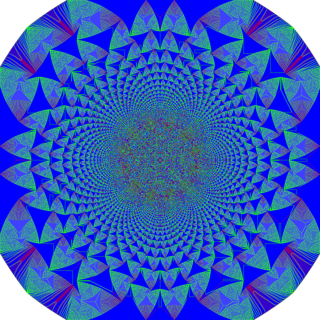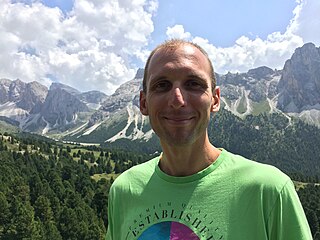Related Research Articles

In statistics, a power law is a functional relationship between two quantities, where a relative change in one quantity results in a relative change in the other quantity proportional to a power of the change, independent of the initial size of those quantities: one quantity varies as a power of another. For instance, considering the area of a square in terms of the length of its side, if the length is doubled, the area is multiplied by a factor of four. The rate of change exhibited in these relationships is said to be multiplicative.

Stuart Alan Kauffman is an American medical doctor, theoretical biologist, and complex systems researcher who studies the origin of life on Earth. He was a professor at the University of Chicago, University of Pennsylvania, and University of Calgary. He is currently emeritus professor of biochemistry at the University of Pennsylvania and affiliate faculty at the Institute for Systems Biology. He has a number of awards including a MacArthur Fellowship and a Wiener Medal.

A power outage is the loss of the electrical power network supply to an end user.

A cascading failure is a failure in a system of interconnected parts in which the failure of one or few parts leads to the failure of other parts, growing progressively as a result of positive feedback. This can occur when a single part fails, increasing the probability that other portions of the system fail. Such a failure may happen in many types of systems, including power transmission, computer networking, finance, transportation systems, organisms, the human body, and ecosystems.

Self-organized criticality (SOC) is a property of dynamical systems that have a critical point as an attractor. Their macroscopic behavior thus displays the spatial or temporal scale-invariance characteristic of the critical point of a phase transition, but without the need to tune control parameters to a precise value, because the system, effectively, tunes itself as it evolves towards criticality.
Per Bak was a Danish theoretical physicist who coauthored the 1987 academic paper that coined the term "self-organized criticality."

Tang Chao is a Chair Professor of Physics and Systems Biology at Peking University.
Extremal optimization (EO) is an optimization heuristic inspired by the Bak–Sneppen model of self-organized criticality from the field of statistical physics. This heuristic was designed initially to address combinatorial optimization problems such as the travelling salesman problem and spin glasses, although the technique has been demonstrated to function in optimization domains.
In physical cosmology and astronomy, dark energy is an unknown form of energy that affects the universe on the largest scales. Its primary effect is to drive the accelerating expansion of the universe. Assuming that the lambda-CDM model of cosmology is correct, dark energy is the dominant component of the universe, contributing 68% of the total energy in the present-day observable universe while dark matter and ordinary (baryonic) matter contribute 26% and 5%, respectively, and other components such as neutrinos and photons are nearly negligible. Dark energy's density is very low: 6×10−10 J/m3, much less than the density of ordinary matter or dark matter within galaxies. However, it dominates the universe's mass–energy content because it is uniform across space.

The Abelian sandpile model (ASM) is the more popular name of the original Bak–Tang–Wiesenfeld model (BTW). The BTW model was the first discovered example of a dynamical system displaying self-organized criticality. It was introduced by Per Bak, Chao Tang and Kurt Wiesenfeld in a 1987 paper.
Maya Paczuski is the head and founder of the Complexity Science Group at the University of Calgary. She is a well-cited physicist whose work spans self-organized criticality, avalanche dynamics, earthquake, and complex networks. She was born in Israel in 1963, but grew up in the United States. Maya Paczuski received a B.S. and M.S. in Electrical Engineering and Computer Science from M.I.T. in 1986 and then went on to study with Mehran Kardar, earning her Ph.D in Condensed matter physics from the same institute.

Matjaž Perc is Professor of Physics at the University of Maribor in Slovenia, and director of the Complex Systems Center Maribor. He is member of Academia Europaea and among top 1% most cited physicists according to Thomson Reuters Highly Cited Researchers. He is Outstanding Referee of the Physical Review and Physical Review Letters journals, and Distinguished Referee of EPL. He received the Young Scientist Award for Socio-and Econophysics in 2015. His research has been widely reported in the media and professional literature.

Global cascades models are a class of models aiming to model large and rare cascades that are triggered by exogenous perturbations which are relatively small compared with the size of the system. The phenomenon occurs ubiquitously in various systems, like information cascades in social systems, stock market crashes in economic systems, and cascading failure in physics infrastructure networks. The models capture some essential properties of such phenomenon.
Robustness, the ability to withstand failures and perturbations, is a critical attribute of many complex systems including complex networks.

The Bianconi–Barabási model is a model in network science that explains the growth of complex evolving networks. This model can explain that nodes with different characteristics acquire links at different rates. It predicts that a node's growth depends on its fitness and can calculate the degree distribution. The Bianconi–Barabási model is named after its inventors Ginestra Bianconi and Albert-László Barabási. This model is a variant of the Barabási–Albert model. The model can be mapped to a Bose gas and this mapping can predict a topological phase transition between a "rich-get-richer" phase and a "winner-takes-all" phase.
In neuroscience, the critical brain hypothesis states that certain biological neuronal networks work near phase transitions. Experimental recordings from large groups of neurons have shown bursts of activity, so-called neuronal avalanches, with sizes that follow a power law distribution. These results, and subsequent replication on a number of settings, led to the hypothesis that the collective dynamics of large neuronal networks in the brain operates close to the critical point of a phase transition. According to this hypothesis, the activity of the brain would be continuously transitioning between two phases, one in which activity will rapidly reduce and die, and another where activity will build up and amplify over time. In criticality, the brain capacity for information processing is enhanced, so subcritical, critical and slightly supercritical branching process of thoughts could describe how human and animal minds function.
Dynamic scaling is a litmus test that shows whether an evolving system exhibits self-similarity. In general a function is said to exhibit dynamic scaling if it satisfies:
Deepak Dhar is an Indian theoretical physicist known for his research on statistical physics and stochastic processes. In 2022, he became the first Indian to be awarded the Boltzmann Medal, the highest recognition in statistical physics awarded once every three years by IUPAP, for exceptional contributions to the subject.
Dislocation avalanches are rapid discrete events during plastic deformation, in which defects are reorganized collectively. This intermittent flow behavior has been observed in microcrystals, whereas macroscopic plasticity appears as a smooth process. Intermittent plastic flow has been observed in several different systems. In AlMg Alloys, interaction between solute and dislocations can cause sudden jump during dynamic strain aging. In metallic glass, it can be observed via shear banding with stress localization; and single crystal plasticity, it shows up as slip burst. However, analysis of the events with orders-magnitude difference in sizes with different crystallographic structure reveals power-law scaling between the number of events and their magnitude, or scale-free flow.

Raissa M. D'Souza is the Associate Dean of Research for the College of Engineering and a Professor of Computer Science and Mechanical Engineering at the University of California, Davis as well as an External Professor and member of the Science Board at the Santa Fe Institute. She was elected a Fellow of the American Physical Society in 2016 and Fellow of the Network Science Society in 2019. D'Souza works on theory and complex systems.
References
- 1 2 3 D. O. Cajueiro and R. F. S. Andrade (2010). "Controlling self-organized criticality in sandpile models". Physical Review E. 81 (1): 015102#R. arXiv: 1305.6648 . Bibcode:2010PhRvE..81a5102C. doi:10.1103/physreve.81.015102. PMID 20365422. S2CID 18171232.
- 1 2 3 D. O. Cajueiro and R. F. S. Andrade (2010). "Controlling self-organized criticality in complex networks". European Physical Journal B. 77 (2): 291–296. arXiv: 1305.6656 . Bibcode:2010EPJB...77..291C. doi:10.1140/epjb/e2010-00229-8. S2CID 12891951.
- 1 2 3 D. O. Cajueiro and R. F. S. Andrade (2010). "Dynamical programming approach for controlling the directed Abelian Dhar-Ramaswamy model". Physical Review E. 82 (3): 031108. arXiv: 1305.6668 . Bibcode:2010PhRvE..82c1108C. doi:10.1103/physreve.82.031108. PMID 21230026. S2CID 32404046.
- 1 2 C. D. Brummitt, R. M. D'Souza and E. A. Leicht (2012). "Suppressing cascades of load in interdependent networks". PNAS. 109 (12): E680–E689. arXiv: 1106.4499 . Bibcode:2012PNAS..109E.680B. doi: 10.1073/pnas.1110586109 . PMC 3311366 . PMID 22355144.
- 1 2 P. A. Noel, C. D. Brummitt and R. M. D'Souza (2013). "Controlling self-organized criticality on networks using models that self-organize". Physical Review Letters. 111 (7): 078701. arXiv: 1305.1877 . Bibcode:2013PhRvL.111g8701N. doi:10.1103/physrevlett.111.078701. PMID 23992086. S2CID 108354.
- 1 2 H. Hoffmann and D. W. Payton (2014). "Suppressing cascades in a self-organized-critical model with non-contiguous spread of failures". Chaos, Solitons and Fractals. 67: 87–93. Bibcode:2014CSF....67...87H. doi:10.1016/j.chaos.2014.06.011.
- ↑ Stefanou, Ioannis; Tzortzopoulos, Georgios (2022-05-23). "Preventing instabilities and inducing controlled, slow‐slip in frictionally unstable systems". Journal of Geophysical Research: Solid Earth. 127 (7): e2021JB023410. Bibcode:2022JGRB..12723410S. doi:10.1029/2021JB023410. ISSN 2169-9313. PMC 9290888 . PMID 35875412. S2CID 249030294.
- ↑ Gutiérrez-Oribio, Diego; Tzortzopoulos, Georgios; Stefanou, Ioannis; Plestan, Franck (2022-03-01). "Earthquake Control: An Emerging Application for Robust Control. Theory and Experimental Tests". arXiv: 2203.00296 [math.OC].